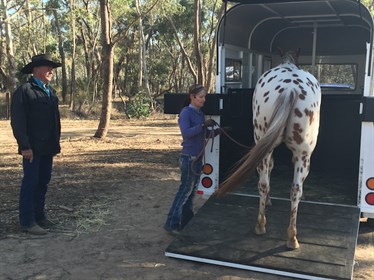|

|
This article has appeared previously with Equestrian Life. To see what's in our current, free digital issue, click here.

A load off your mind
By Ken Faulkner (Photos courtesy of Ken and Kathy Faulkner)
Travelling with horses can be a challenge, especially if your horse is hard to load on the trailer. The key, as usual, is training. Let’s break down problem-floating and see how to work with our horses to make loading and travelling a shoo-in.
IT’S A FOREGONE conclusion that most horse owners will at some time choose or need to move their horse in a float or truck. It can be a stressful time until we know our horse can handle the pressure of an unknown stage of his education, so it isn’t a good idea to just throw him in the deep end. Instead, we should strive to help him and use the opportunity to educate him to be a nicer, all-round riding horse.
A stressed horse or defensive horse may look at the trailer as a cave that predators live in. Being a prey animal, it would be easy to trigger a reaction that animal behaviourists call reverse psychology. Basically it means that in the wild a prey animal is programmed by nature to do the opposite of what a predator wants. This may explain why when we get a horse half in the trailer and put pressure on him to continue further in, he runs out.
Another important feature of the prey animal (horse) is that they are claustrophobic in tight areas because it may limit or block their ability to run from perceived danger.
It is helpful to remember that horses move as a reflection of their primary emotion, in fact, every time they move they show the depth of their training by being less emotional and become braver. As with all horse training, we know that nothing works well and is less permanent when we try to use force. Trailing is no different. Some people try to pull the horse into the trailer by the halter, causing the brace and resistance that stops him from loading. In fact if your horse is half in the trailer and you pull on the halter lead, he may throw his head and hit the roof, thus adding even more fear of the trailer. I actually think horses that nod or throw their heads as they approach the trailer are a product of this type of trailer loading. Locking arms behind your horse in an attempt to push (pull) him into the trailer will only result in the same brace and reluctance. I hope this helps us to see the situation from the horse’s perspective.
What can we do?
A proactive trainer would start as early as possible to condition his or her horse in preparation for situations like trailer-loading and many other possibilities. Horses learn by conditioned response caused by habitual training, comfort versus discomfort, and approach and retreat.
Probably the first thing we need is a horse that leads well; a horse that will give softly to pressure on the lead rope, forwards, right and left and backwards. Don’t forget you will need to unload your horse when you arrive at your destination.

It would also help if you can drive your horse from beside him. Introducing your horse to obstacles and situations will help him be braver and more informed. Can you walk the horse over logs large enough that he would need to lift his feet and bend his knees and hocks from beside as well as in front? Walking around and over objects that make a hollow sound, like bridges, ramps, tarps, seesaws etc. would definitely be recommended. These sounds can scare some horses, especially sounds and surfaces that don’t feel or sound solid.
If it’s possible, putting a rug on your horse can help him be less claustrophobic; draping a light rug or tarp all over him (even his head) can help. Remember, be gentle and support him. Talk and rub him lots. Take lots of time and wait until he relaxes with each step.

Can you walk your horse into and out of a stable or large shed? If he can see through and has room, he can learn to relax. It would be a good idea to feed your horse in there as well. Food does wonders to take the mind off scary things. It would be reasonable to assume that if a horse isn’t relaxed in a stable or shed, it would be the same or worse in the trailer.
Now we introduce the trailer. Can you have it sitting around when you work him? Use it as the centre of your circle work. Have it open so he can see it. When you want to rest, rest at the trailer so he can learn to see the trailer as a comfortable place. You can do this on the lead or ridden. Both work well. At first, resting at the ramp of the trailer would be a good start. Our aim would be to have him rest with his front feet on the ramp. He can hear and feel and see the situation without too much pressure on him. At this stage of your horse’s education you could now ask your horse to walk across the ramp from side to side without stepping off it.

We could remove the dividers in the trailer to create the illusion of a more open space. By now your horse has learned to trust your direction, so you could ask him to enter the trailer just a little way, rest a moment, and then you back him out before he decides to escape. At no time at this point should you try to force the horse to stay in the trailer. If he should back out without being asked, a better idea would be to put your horse to work with as many ground skills as you know. Then again let him rest as close to “in the trailer” as you can get. Create a sweet spot at or in the trailer by using comfort and discomfort effectively.
At some point it would also help to condition your horse to a breaching bar by putting a rope around his hindquarters and asking him to step forward, using light tugs to ask him forward and really soften the rope when he does. This would help if he should step backwards and touch the breaching bar.

A lot of horses get stuck and don’t feel they can move their feet when they enter a trailer, so loading and unloading as well as moving the horse’s feet while loaded can help him relax. Now it’s time to put the divider back in the trailer... slowly putting it in place while the horse rests in the trailer.
If my horse is relaxed through as many steps as I can think of, only limited by my imagination, it’s time to move the trailer. It’s a good idea to have your horse well exercised to collect a more settled attitude that only wet saddle blankets can achieve.
A few short rides with a dependable coach horse would be the next step. Be smooth when you start, stop, and especially, corner.
As with any training we need to be careful and prepared for unexpected issues.
- A knife in case you need to cut a rope, and
- An easily removable divider
This is a rough outline of how we teach our horses to float. Of course, we must be prepared to make adjustments as we go. It’s a fun journey to see my horses become better trained and to help them to be more dependable, generous and safe.
READ THE LATEST NEWS ARTICLES HERE

|

|

